by Winding Pathways | May 31, 2018 | Birds, Nature
Reflecting on Heron Rookeries
Guest blog by Sigrid Reynolds
Heron rookeries are one of the most peculiar sights you will see.
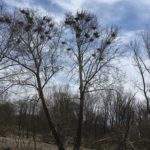
Photo by Sigrid Reynolds
Picture three large sycamore trees in the middle of a swamp in Ohio. Skunk cabbages, those harbingers of spring, poke up along the early pioneer road that crosses these wetlands. One narrow parking spot across the street hosts cars and vans while up to 20 nature lovers with binoculars and huge camera lenses stand on the shoulder across the street. Clacking, clicking sounds pulse from the trees that host more than a score of messy stick nests. About half of them have great blue heron silhouettes standing sentry nearby. By late April, fluffy chicks poke their heads up from under a parent. And, by June, the adolescent chicks, now the size of their parents, still demand food.
Hmmm, one’s mind drifts to adolescent humans taking over home acreage while ravenously emptying the fridge.
Great Access
This heron rookery between Cleveland and Akron, Ohio, has sheltered generations of great blue herons and has delighted visitors to the Cuyahoga Valley National Park every Spring. Rookeries abound across the US but few are as accessible as this one, less than eight miles off I-80. Along the same interstate in the Indiana Dunes, is an enormous rookery of up to 98 mating pairs. It is closed to visitors during nesting season.
Herons return each year (as do the nature photographers) and re-inhabit their nests, adding more limbs and sticks as needed. One year in a Nebraska swamp, herons arrived to find an eagle pair has appropriated their home.
Squatters
Eagles nest earlier than herons and find that their nest makes the perfect platform for more sticks. A tussle seems to go on between these two large species of birds. YouTube has intriguing videos of eagles vs. herons. Here is an amazing one. Usually, eagle activity won’t drive the herons away but does cause turmoil.
Human endeavors do drive off herons. When wetlands are drained for subdivisions, the amphibians and fish that feed herons disappear. So, these magnificent birds must seek a landscape that can sustain them and their hungry families.
Our parks and nature preserves protect these nesting sites so that we can continue to see the solitary visitors we welcome to our neighborhood ponds and creeks. I’m grateful for these preserves every time I sit on my back patio watching “our” heron arrive. He lands on a branch of my neighbor’s big pine to peruse food possibilities before he heads down to the shores of the small pond that marks our property line.
-
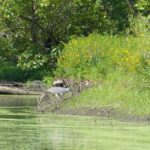
-
A Heron waits patiently for a fish.
-
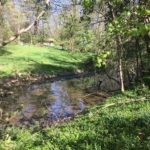
-
Small pond in back yard.
by Winding Pathways | May 3, 2018 | Birds, Mammals, Nature
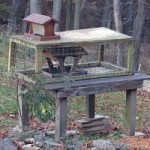
Keeping Squirrels at bay
Bruce Frana, a Winding Pathways visitor, saw one of our blogs on our “squirrel proof” feeder and how we discourage squirrels from gobbling up sunflower seeds we put out for birds. He crafted a similar but much more attractive version that’s in his yard. Our contraption is a box framed with 2X2 lumber with sides of 2” x 2” wire mesh. A piece of plywood forms the roof, and we attached it to a wooden table with a pair of hinges. The hinges let us lift the cage to sprinkle sunflower seeds inside.
It works. Sort of. Cardinals, chickadees, and nuthatches easily pass through the wire mesh to feed. Some squirrels and wild turkeys, which we like but get frustrated when they gobble up all the seed, can’t get through the mesh. Our fox squirrels are too chunky to squeeze through, but smaller gray squirrels manage to get in and gobble seeds. We could keep the grays out if we could find 1 ¾ x 1 ¾ mesh wire on the market. As far as we know it doesn’t exist, but if it did it would let birds in but exclude even the skinniest gray squirrel.
Bruce reports that his fox squirrels can’t enter either but the grays do. Here is a photo of his squirrel foiling feeder:
Do It Yourself “Squirrel Proof” Feeder!
Here is what he shared: “I have had a platform feeder for several years but, like your blog mentioned, turkeys, and even some clever squirrels, were able to get on top of it. I built (a feeder) based on the plan/picture you shared on your blog. I adapted the plan to the platform feeder I had and made some of my own modifications.
“As you can see from the pictures, I attached the structure onto the original platform by using hinges, just as your plan had done. I also put a pitched roof and handle to be able to easily lift the one end to place seed on the platform. The entire system is attached to a 2″ PVC pipe that slides over a steel post. I have had one ingenious small grey squirrel figure out how to get into the feeder and solved that problem, at least for now, by making the wire openings a bit smaller on two sides.” It works…sort of!”
Readers can go online and find “Do It Yourself” (DYI) “squirrel proof” feeder instructions. Good luck and let us know how it goes! Thanks, Bruce Frana.
-
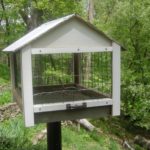
-
Adaptation to feeder
-
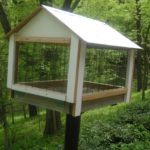
-
Back View of feeder
by Winding Pathways | Mar 29, 2018 | Birds, Nature
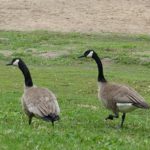
Geese mate for life.
“Loose as a goose” is an apt expression. Many people dislike Canada Geese for their habit of depositing droppings on trails and lawns. Despite their mess geese are intriguing birds, especially if they are carefully observed. We enjoy watching them all year and love the goose music they treat us to as they wing over our home at Winding Pathways.
Young Canada Geese form pair bonds early in their lives and have high fidelity to their mate for what can be a long life together. Urban geese enjoy an enviable lifestyle. They eat lawn grass and insects common in town and also snack on grain dropped from railroad cars and an occasional dying gizzard shad. Food is plentiful, and few predators pester adult geese. They have plenty of time for loitering and often socialize and rest with the flock in the shade on hot summer days or in the sunshine when the temperature is cool.
Coupling Up
Geese follow an easy to observe pattern. In late February or early March, goose couples separate from the flock and can often be seen together. Males and females are identically marked. But the male ganders are usually slightly larger and have a thicker neck than their mate. Females make a nest sometimes hidden in vegetation on the ground and lined with a few sticks and goose down. Often their nest is on a muskrat house or another high spot. Sometimes they’ll even nest on a platform up in a tree. We’ve even seen one couple that became squatters in an eagle nest!
So, the nest can be hidden or very visible. It is usually near water. The female lays two to eight eggs and begins incubating once the entire clutch is complete. They hatch in 25 to 28 days, so most goslings appear in early to mid-April.
Parenting
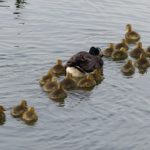
Goslings with the adult.
Geese are wonderful parents and defend their nest and babies from intruders. This includes bicyclists and trail walkers! Geese spend hours teaching their babies how to find food and avoid hazards. Few raccoons, foxes, or other predators are big and bold enough to kill an adult, and mature geese aggressively protect goslings. They hiss if a human or dog approach too closely.
Baby geese grow amazingly quickly and by late summer are only slightly smaller than their parents but otherwise look the same. Following the mating season geese flock up in large groups of family and friends and stay together until next spring’s mating season.
Feasting and Loafing
Many geese spend their nights on and near urban ponds and rivers. Early each morning they fly to farm fields to feast on waste grain and grass. Often, they return to town in the late afternoon to treat humans to their beautiful call as they wing overhead. They are one of our favorite birds to see and hear at Winding Pathways.
by Winding Pathways | Mar 26, 2018 | Birds, Children/Play, Nature
“Something Going On in that Tree”
Guest Blog by Wahneta Dimmer
Todd and I sat at the breakfast table – coffee for me and a coca cola for him – looking out the sliding glass doors at the backyard and out into the park beyond. As he half read the newspaper Todd said, “Hey, look in the tree, there is a big bird sitting on that lower branch.” It took me a minute to find the object he was focusing on but sure enough, there in the early morning light, sat a large bird shadowed by snow-covered branches. We are accustomed to having many small birds visit our feeders throughout the winter but to see a predatory bird is rare. And so low and close to the house, seemingly eyeing the park for prey, is exceptional! We watched for a while before going on about our morning.
Both the kids were spending their third day home from school, recovering from a winter virus, not too sick to stay in bed but just miserable enough to lay low. Kael was standing at the same sliding glass doors when he excitedly exclaimed, “There is a fight or something going on in that tree, Mom.” I told him about the large bird his dad and I had seen earlier in the morning. As we watched, snow was flying out of the upper branches and cascading downward. Kael imagined the bird duking it out with a squirrel! Suddenly, the bird dropped from the tree and flopped into the snow. I said to Kael that it looked like a red-tailed hawk. He wasn’t sure he agreed but we thought we should investigate.
Reconnaissance, Research and Rescue
We both hastily bundled up and headed out across the backyard. As we approached the landing zone, the bird jumped away dragging a wing with him. Kael and I agreed on two things: positively a red-tailed hawk and clearly, injured. Knowing any attempt to get closer would exhaust its remaining reserves, we retreated to the house and called for backup. Kael researched online what to do with an injured raptor and settled on the RARE program. According to their website, the program focuses on rescue, triage and long term medical treatment of injured, sick and distressed raptors. Todd and the kids asked for advice on how to gently capture the bird and safely transfer it to the Iowa City facility. They settled on a wool blanket and dog carrier and as the best options.
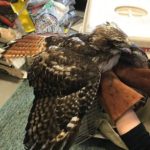
Injured Hawk
True to February in Iowa, it was sunny and brisk with temperatures in the mid 30s and a breeze that made you think is was much cooler. Todd, Kael and Ava headed out into the park just after lunch to relocate the missing, injured raptor. The guys went to the right toward the ball diamond while Ava intuitively chose to head out the gate to the left. Within minutes, Ava located the injured hawk resting at the base of a crab apple tree. She called the guys over, and taking the advice of the RARE associate, they got just close enough to toss the wool blanket gently over the hawk and then Todd scooped him up! The poor bird was so cold and tired, he didn’t even fuss when they put him in the dog carrier, covered him up again and closed the door. As they drove to Iowa City, they wondered aloud what had happened to it and whether it would recover.
Rehabilitation
When they arrived at RARE, rehabilitator, Nikki Herbst, greeted them, assessed the newest arrival, determining it probably was a male hawk, and told them about what the rehab center does. She even introduced them to some of the permanent residents, those too injured to be released into the wild. “Miss Nikki” wasn’t too optimistic as she assessed the hawk. It seemed too weak to stand on its own, much less eat.

Ava Rare Champion Hawk Award
She was kind enough to award the kids with a RARE Wildlife Champion Award and thanked them for their service. Her parting words were, “No news is good news,” meaning she would only call us if he died. If he were to be released, it would be done with discretion at the same place that the bird was found.
Release
Five weeks later, much to our surprise, we received a joyous call from “Miss Nikki.” She was eager to share the news that our hawk rescue was successful, and he was ready to be released. She wondered if we would like to participate?! She went on to say that he was back to his feisty self and flying around the indoor enclosure as high to the ceiling as he could. He was completely recovered from his injury, a broken femur! We agreed on a time with the place predetermined, the park – just outside our backyard.
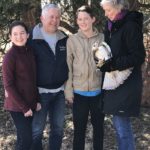
Dimmer family with Nikki and hawk
After a few family pictures and with the hawk in a box, “Miss Nikki” coaxed the Red-Tailed Hawk from his cardboard carrier and invited him to see again the park and his home. With a count of one, two and three, she encouraged him into the air and off he flew. He paused for a moment at the top of an oak tree before taking off across the park.
Three cheers for the Red-Tailed Hawk, for lessons learned and for good deeds done!
We have a RARE chance to help out: The Raptor Advocacy Rehabilitation & Education (RARE) is based out of Iowa City and is a 501c3 organization. For more information please visit their website at www.theraregroup.org
Photo Journey of Release
-
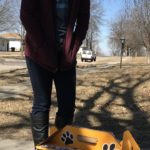
-
Ava by carrier.
-
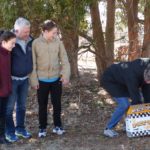
-
The Dimmer family watches as Nikki brings hawk out of the carrier.
-
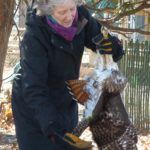
-
Hawk out of box
-
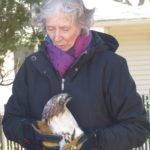
-
Woman hold hawk
-
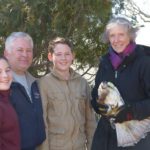
-
Ava, Todd, Kael, “Miss Nikki” and hawk.
-
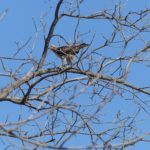
-
Hawk in tree
by Winding Pathways | Oct 26, 2017 | Birds, Nature
This fall thousands of hunters will bring millions of ringneck pheasants home to be converted into delicious meals. Pheasants have been around so long that many people think of them as native birds. They’re not but they provide a lesson on how to structure a modern yard to attract wildlife.
In the 1880s Judge Owen Denny was stationed as a government agent in China. He and his wife took a fancy to colorful and tasty pheasants, which are native to Asia. They had some captured and shipped to Portland, Oregon where Denny’s brother released them on the family farm. They reproduced like crazy, and just ten years later Oregon opened the nation’s first pheasant season. About 50,000 were shot.
Pheasants began spreading out on their own and people speeded the process by capturing many and releasing them all over the country. The birds never took hold in the hot humid south but thrived in northern farmland that was a patchwork of grain and hayfields separated by brushy fence rows. By the mid-1900s they were abundant in the Midwest and eastward to the Atlantic wherever farms provided the right habitat.
Pheasants live near human activity. They love farmland yet shun forests. The bird did well until enormous changes in agriculture took place in recent years.
Because of rises in grain prices, huge increases in the size of agriculture machinery and fields, and modern pesticides farmers began tearing out the brushy fencerows the birds loved. As corn and soybean prices shot upward hayfields began to disappear. Pheasants lost safe places to nest.
Because of habitat loss pheasant populations are smaller than they once were but when habitat improves pheasant numbers swiftly rebound. It’s a good lesson for homeowners.
Pheasants generally aren’t backyard birds because most people live in shady suburban neighborhoods or big cities. Homeowners with yards backing up to farm fields might enjoy pheasant visits but otherwise, the birds are denizens of agricultural land.
However, pheasants provide a graphic example of the importance of habitat that applies to all species, including the loved and valued wildlife that lives in suburbia – or might if they find good living conditions. Chickadees, woodpeckers, goldfinches, cottontails, barred owls and dozens of other fascinating animals enjoy sharing yards with humans. If backyard habitat is improved they will come.
Here are a few ways to structure a yard, even a tiny one, to attract a variety of interesting wildlife:
- Create Diversity. Plant trees, shrubs, grasses and flowers that offer wildlife food and shelter. The greater the diversity of plants the greater the number of species that will take up residence.
- Shun Pesticides.
- Provide water. A tiny backyard pool or even birdbath will be appreciated by wildlife
Adding food might or might not help wildlife. It depends on what expert you consult, but adding a feeder certainly encourages wild animals, especially birds, to come close to the window so they can be seen. One of the very best seeds to put in the yard is black oil sunflower, which many species enjoy. The worst is milo, which is shunned by native species but devoured by House Sparrows. Corn is inexpensive and enjoyed by many wild animals.
An exciting and rewarding project is converting a sterile mowed and sprayed lawn into a wildlife haven. Pheasants probably won’t come but dozens of beautiful and interesting animals will.
by Winding Pathways | Jul 13, 2017 | Birds, Nature

A visit with Sibley
In June, we had the delightful experience of hearing ornithologist David Allen Sibley address members of the Outdoor Writer’s Association of America. Following his talk, he chatted with us about his career, birds, and how people can best attract and enjoy birds in their yard.
Mr. Sibley is an ornithologist, artist, and writer who created the acclaimed SIBLEY GUIDE TO BIRDS, SIBLEY GUIDE TO BIRD LIFE AND BEHAVIOR, and SIBLEY GUIDE TO TREES. All are beautifully illustrated with his detailed and amazingly accurate paintings. Field guides have been around for decades and identification can become confusing because some species look slightly different in varied parts of the range. So, what makes his books so useful is the series of paintings of each species. Also, young birds often look different than their parents. To help identify them the Sibley guide shows plumage variations within a species.
The SIBLEY GUIDE TO BIRDS is designed to help identify species. It’s companion, THE SIBLEY GUIDE TO BIRD LIFE AND BEHAVIOR, provides detailed information about each species. The SIBLEY GUIDE TO TREES helps identify and learn about tree species. Additionally, Sibley has illustrated a number of other guide books and Bright Wings: An Illustrated Anthology of Poems About Birds, by Billy Collins.
In the interview, Sibley shared that birds “blur the boundary of wildness.” They come and go in our lives whereas trees are integral. “They are part of nature that is part of our lives.”
David Allen Sibley’s father was a noted ornithologist who, although he didn’t push his son to follow in his footsteps, often brought his young son on outings. “I always had a good time tagging along with my father and learned a lot by rambling about, turning over logs to see what was underneath them and just exploring,” he said. Then, he started drawing sketches of birds which he showed us. The progression of skill from black and white drawings he did as a kid to the colorful paintings as a professional is remarkable.
Sibley’s interest has evolved over the decades. Initially the excitement was the challenge of finding a bird and drawing it. The hunt, if you will. The field guides shifted his attention to the academics – how birds are similar and different. Now, with these projects completed, his attention has turned to the wondering phrase: What do birds do? How do they survive all the amazing things they do?
When we asked him, what people can do to encourage kids’ awareness of nature and make their yards a better place for a diversity of species he thoughtfully reflected. “Just provide opportunities to get the kids outside to mess around, to get comfortable being outside,” he noted. “Leaving even a small area wild, maybe the edge of a yard, will help increase habitat diversity. Encouraging brush or tall grass may attract a song sparrow that wouldn’t visit a totally mowed and clipped yard. Seeing an unusual and interesting bird in the back yard might spark a child to pursue a nature-related career or hobby,” he added.
We broached the topic of outdoor pests like ticks and mosquitoes tat so freak out urbanites. “Our risk assessment is skewed,” he stated. “It’s like shark attacks, those fears are over emphasized,” he added. The uptake is, be aware, take precautions by wearing appropriate clothing, use repellent and do a check when you return and throw clothes in the laundry.
Meeting David Allen Sibley was a thrill. We can’t imagine being without his books and were delighted to learn that as a child rambling about in nature led to his distinguished career. Most children won’t grow up to be artists or ornithologists, but a wondrous diverse and healthy back yard will inspire them to enjoy the outdoors and appreciate the amazing wild creatures that live there.
David Allen Sibley’s books are widely available online and in most bookstores. He recently has been involved in developing a new way to identify both birds and bats by sound. Called Song Sleuth, the phone app identifies bird song. A somewhat similar Echo Meter Touch bat app uses an ultrasonic microphone that picks up the echolocation of flying bats and identifies them by species.
For information check out the following:
Books: www.sibleyguides.com
Song Sleuth: www.songsleuth.com
Echo Meter Touch bat app: www.echometertouch.com
Winding Pathways has no formal affiliation with David Allen Sibley, his books, or the phone apps noted in this blog. We posted this because Mr. Sibley and his books and apps have helped us learn about the wondrous birds and trees in and around our yard.


















